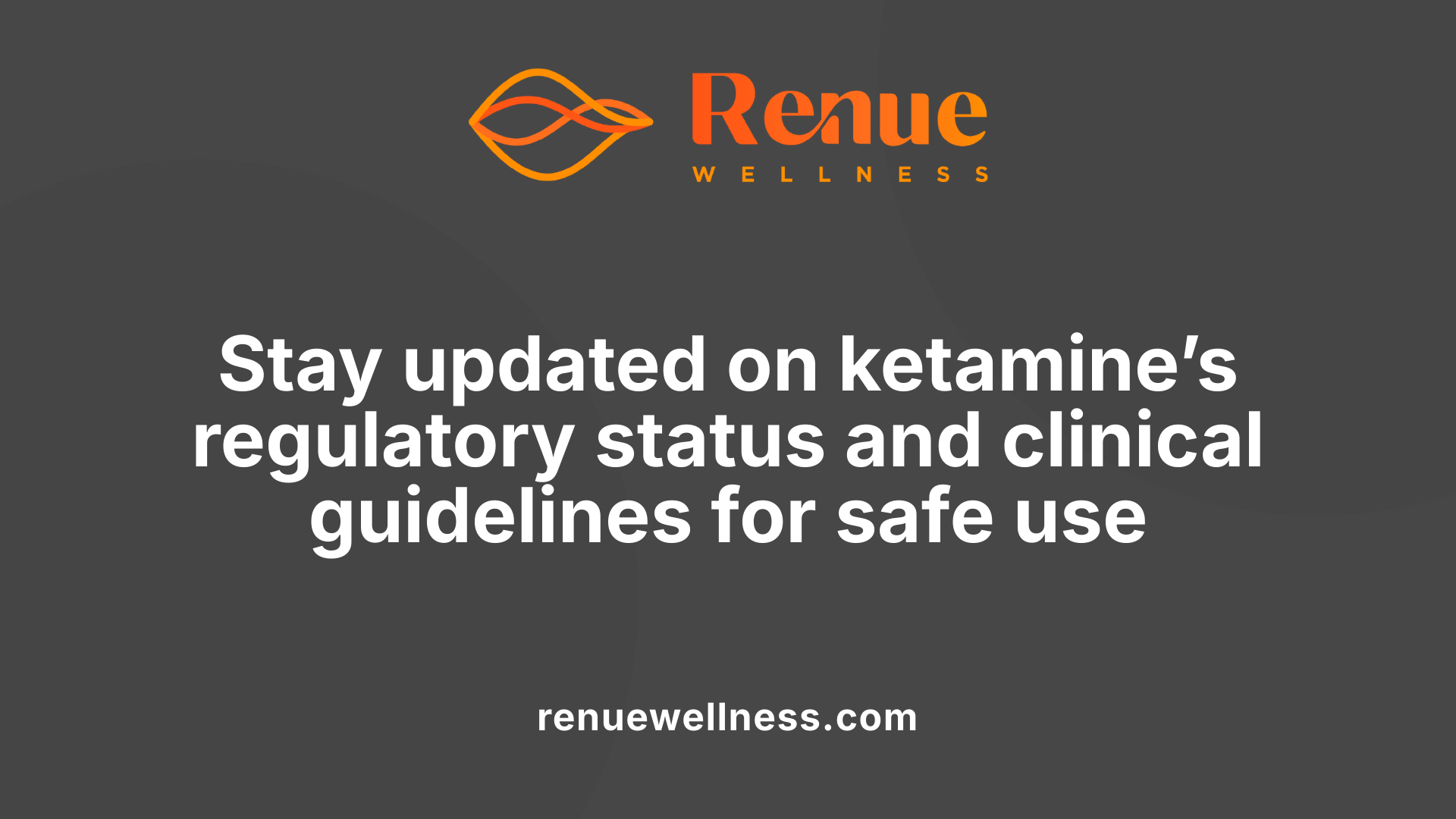Can Ketamine Therapy Be Used Long-Term?


July 23, 2025
Understanding the Potential and Pitfalls of Long-Term Ketamine Use
Ketamine, a medication originally approved as an anesthetic, has emerged as a promising rapid-acting intervention for treatment-resistant depression and other mental health conditions. While its efficacy for short-term symptom relief is well-supported, questions remain about the safety, effectiveness, and regulatory status of long-term use. This article explores whether ketamine therapy can be safely extended over months or years, examining clinical evidence, potential risks, and guidelines for responsible application.
The Efficacy of Repeated Ketamine Infusions and Their Duration of Effect

How effective is sustained ketamine treatment for mental health conditions?
Repeated administration of ketamine has shown promising results in treating severe mental health disorders like treatment-resistant depression. The positive effects of ketamine therapy can last for days to up to a month after a single infusion, with some studies reporting benefits that extend even longer. Specifically, the antidepressant effects tend to be most rapid, peaking around 24 hours post-infusion, and typically last between 1 to 3 hours, with residual effects potentially lasting another 1 to 3 hours on the same day.
Research indicates that with multiple sessions, the impact can be more sustained. Patients often respond strongly after an initial series of infusions, such as six over 2-6 weeks. Following this, many can maintain symptom relief for several weeks, sometimes up to 7-8 weeks or longer. Some individuals need booster treatments at intervals of every 3 to 4 weeks to continue experiencing benefits. These ongoing treatments are usually tailored based on individual response and symptom recurrence.
Long-term use of ketamine, especially in clinical settings, has generally been tolerated well. Studies conducted over 12 to 45 sessions spanning 14 to 126 weeks have not reported significant cognitive decline or other severe adverse effects. This suggests that with proper medical supervision and dosing protocols, sustained treatment can be both effective and safe.
Furthermore, combining ketamine with additional therapies such as psychotherapy, lifestyle adjustments, and interventions promoting neural resilience appears to help prolong its benefits. These strategies may enhance synapse formation and support longer-lasting symptom remission.
In summary, sustained ketamine treatment offers rapid and durable relief for many individuals suffering from resistant depression, with benefits persisting well beyond the initial treatment phase. While the evidence supports its efficacy, ongoing research continues to refine our understanding of the optimal treatment protocols and long-term safety.
Long-Term Safety and Cognitive Impacts

What are the potential long-term side effects of ketamine therapy?
While ketamine is primarily used for its rapid antidepressant effects, its long-term safety profile warrants careful consideration. Potential adverse effects, especially with repeated use, include bladder problems such as ketamine-induced cystitis, which can cause symptoms like frequent urination, pelvic pain, and, in severe cases, bladder damage requiring surgical intervention.
Cognitive impairments are another concern, particularly affecting memory, attention, and sensory processing. Studies suggest that long-term or high-dose use might induce verbal, visual, or short-term memory deficits, with some evidence pointing toward structural brain changes. There is also a risk of psychological dependency; some individuals may develop tolerance, leading to increased doses and withdrawal symptoms such as cravings or mood disturbances.
Brain regions involved in reward and cognition—like the prefrontal cortex, hippocampus, and nucleus accumbens—may undergo neurobiological changes with persistent ketamine exposure. These could manifest as emotional changes, personality shifts, or worsening of psychiatric symptoms.
It's important to note that most adverse effects are linked to recreational misuse or high-dose long-term use. Clinical doses, when administered responsibly under medical supervision, tend to have a lower incidence of such problems. Still, ongoing monitoring is essential to ensure patient safety and to distinguish between beneficial therapeutic effects and potential harm.
Continued research and careful observation are necessary to better understand these long-term impacts and to optimize treatment protocols that maximize benefits while minimizing risks.
Current Research, Regulations, and Clinical Practice Guidelines

What is the official approval status of ketamine?
As of now, ketamine is officially approved by the U.S. Food and Drug Administration (FDA) solely as an anesthetic agent. Its approval for long-term mental health treatment, such as depression or suicidality, remains unapproved. However, a nasal spray form of ketamine, known as esketamine, received FDA approval in spring 2019 for treatment-resistant depression, and in August 2020, this approval was expanded to include patients with depression experiencing suicidal thoughts or recent self-harm. Despite these approvals, most ketamine uses for mental health conditions occur off-label, especially in intravenous and oral forms.
Are there established guidelines for long-term ketamine use in clinical practice?
Yes, emerging guidelines are being developed to oversee long-term ketamine therapy, particularly for resistant depression. These guidelines emphasize meticulous patient selection, excluding individuals with active substance abuse, unstable medical conditions, or psychosis. Treatment usually occurs in specialized clinics with trained healthcare professionals who monitor patients closely.
Protocols often include regular assessments of vital signs, adverse effects, and symptom relief, typically after several infusions. For example, some health authorities and researchers, such as Beaglehole et al in New Zealand, are working toward comprehensive national standards. These include registration processes, pharmacovigilance measures, and safety protocols aimed at minimizing risks and ensuring proper patient management.
What are the risks associated with unregulated practice?
Unregulated or unsupervised use of ketamine poses significant safety concerns. Many non-clinical settings, including in-home compounded preparations and cash-only clinics, lack standardized dosing, safety protocols, and comprehensive patient monitoring. This increases the risk of adverse reactions, overdose, dependency, and serious organ damage such as bladder cystitis or liver issues.
Furthermore, self-medicating with ketamine can lead to psychological dependence, cognitive impairments, and exacerbation of psychiatric symptoms like hallucinations or paranoia. Long-term or high-dose use elevates cardiovascular risks, including increased heart rate and blood pressure, posing additional dangers for susceptible individuals.
To mitigate these risks, regulatory bodies and healthcare providers advocate for strict clinical oversight, adherence to guidelines, and ongoing patient assessment. Patients should seek treatment from licensed practitioners operating within approved protocols to ensure safety and efficacy.
| Aspect | Details | Additional Notes |
|---|---|---|
| FDA Approval Status | Approved as anesthetic; esketamine approved for depression | Off-label uses are common in clinics |
| Guidelines for Long-term Use | Emerging, focus on safety, patient selection, monitoring | Developing for responsible clinical practice |
| Risks of Unregulated Practice | Dependency, organ damage, cognitive issues, overdose | Higher in non-clinical, unsupervised settings |
This framework underscores the importance of formal guidelines and medical supervision in ketamine’s therapeutic use, aiming to maximize benefits while minimizing risks.
Risks, Dependency, and Long-Term Adverse Outcomes
What is known about the safety and risks of long-term ketamine therapy based on current research?
Research indicates that extended use of ketamine can lead to several health concerns. Brain imaging studies have documented structural changes such as decreased gray matter volume and reduced white matter integrity, along with altered brain connectivity impacting memory, cognition, and motor functions. Neurotransmitter systems, including dopamine D1 receptors, may also be affected, potentially increasing vulnerability to addiction.
Clinically, repeated ketamine treatments can result in tolerance, leading to physical and psychological dependence. Withdrawal symptoms are possible if use is abruptly stopped, and cognitive deficits—including memory problems and altered sensory processing—may develop with prolonged exposure.
The risk of bladder and urinary tract issues is significant. Long-term, high-dose use has been linked to severe bladder damage, such as ketamine-associated cystitis, causing symptoms like frequent urination, pelvic pain, and reduced bladder capacity.
Psychologically, long-term users might experience mood swings, dissociation, paranoia, and in some cases, psychosis or worsening of pre-existing mental health disorders. Physical health risks include increased heart rate and blood pressure, posing dangers for individuals with cardiovascular conditions.
Given the limited long-term safety data outside controlled environments, medical oversight is essential. Current evidence highlights the importance of cautious, supervised use of ketamine, especially when considered for ongoing treatment. More studies are needed to establish comprehensive safety profiles and guidelines for long-term therapy.
Timing of Effects and Maintenance Strategies
How long does the therapeutic effect of ketamine last, and is maintenance therapy necessary?
Ketamine's initial antidepressant effects are usually rapid, often beginning within approximately 40 minutes after infusion. The peak of these effects is generally observed around 24 hours post-treatment, with symptom relief lasting for about 1 to 3 hours during the infusion, and residual effects persisting for up to a few hours.
In terms of duration, a single ketamine infusion can provide relief for several days to up to a week. Some patients experience effects that last even longer, especially with repeated infusions. Research indicates that after an initial series of treatments—typically 6 infusions over 2 to 6 weeks—the benefits can extend, with ongoing relief lasting from weeks to over a month.
To maintain these benefits, clinicians often recommend booster infusions roughly every 3 to 4 weeks. This interval may vary depending on individual response, with some patients requiring more frequent or less frequent doses.
Strategies aimed at prolonging ketamine’s positive effects include combining treatments with psychological therapies, lifestyle modifications like improved sleep and exercise, and pharmacological agents that support synaptic growth. These approaches may help sustain benefits and potentially extend the duration of remission.
In conclusion, while ketamine offers quick relief, long-term management often involves periodic maintenance infusions. Treatment plans are highly individualized, focusing on maximizing benefits while minimizing risks and side effects.
Balancing Benefits and Risks in Long-Term Use
While ketamine offers rapid relief and promising long-term benefits for some patients with resistant depression, its long-term safety profile remains inadequately researched. The potential for neurobiological and physiological side effects, dependency, and structural brain changes warrants cautious application within supervised clinical settings. As research progresses, developing standardized guidelines and carefully monitoring outcomes will be essential to ensure that the therapy remains both effective and safe over extended periods. For now, clinicians and patients must weigh the significant therapeutic potential against the uncertainties of long-term use, emphasizing personalized treatment plans and ongoing assessment.
References
- On the safety of repeated ketamine infusions for the treatment of ...
- What to Know About Ketamine | Johns Hopkins
- How Long Do the Positive Effects of Ketamine Therapy Last?
- Acute and longer-term outcomes using ketamine as a clinical ...
- Analysis of Prolonged, Continuous Ketamine Infusions
- Ketamine: The Benefits Continue to Unfold - NewYork-Presbyterian
- Sustaining Results With Ketamine Treatments - Lone Star Infusion
Recent Posts
Conditions Treated
AnxietyDepressionOCDPTSDPostpartum DepressionPain ManagementSubstance AbuseSuicidal IdeationOur Location


